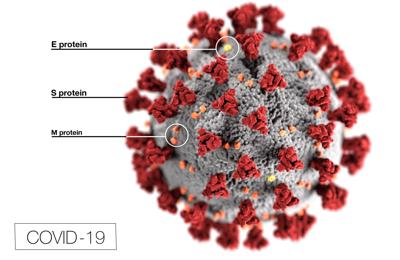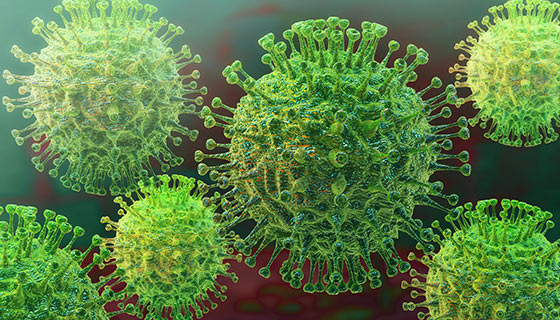
A Sense of Doubt blog post #1983 - Is Coronavirus more contagious and more deadly than the flu? YES.
This blog post came from a personal interaction. Someone close to me claimed that Coronavirus and the disease it causes, COVID-19, is no worse than the flu. "People also die from the flu every year."
I did not feel I had the adequate counter arguments at my finger tips to let this person know how wrong they are about this issue, and so I felt I wanted to gather facts, corroborate facts from multiple sources, establish the credibility and credentials of those whose facts I am using, and get clear in my mind the main arguments for why we're in the midst of a global pandemic because COVID-19 is a serious, lethal, and wildly contagious virus for which we currently have no vaccine.
Later, the conversation with this person switched to the idea of "fake news" so prevalent as a dismissal by certain people of science, facts, truth, and reality. It seems to me this dismissal of most news as "fake," the tendency to point out any counter view or indictment of wrong-doing as a "hoax," or limiting comparisons based on faulty, incomplete, and/or completely incorrect assertions be ill-informed people of limited critical thinking ability comes from a deep fear of uncertainty and a lack of ability to cope with the unknown.
So, let's be clear.
COVID-19 is much more contagious and deadlier than influenza.
We have a vaccine for influenza, which is revised each year to target the most recent strains of the virus. We do not have a vaccine for COVID-19, and when we do, like the flu, many people will choose not to get it, which will put all of us further at risk and keep us from achieving herd immunity.
Fatality rates? WORSE. This from the MEDIUM article published at the end of this post:
In fact, if we take a reasonable range from most of the published research, it looks like COVID-19 has a fatality rate roughly 50–100 times higher than influenza. In other words, between 1 and 10 in 100,000 people who get the flu will die, but between 500 and 1,000 in 100,000 people who get COVID-19 will pass away.
 |
| https://www.bloombergquint.com/opinion/how-bad-is-the-coronavirus-let-s-compare-with-sars-ebola-flu |
Sharing facts and data from a top doctor at Ohio State University's Wexner Medical Center; from Lisa Lockerd Maragakis, M.D., M.P.H., senior director of infection prevention at Johns Hopkins University School of Medicine, and a self-proclaimed "health nerd," known as Gideon M-K, an Epidemiologist. Blogger. Writer (Guardian, Observer etc). PhDing at @UoW Host of @senscipod.
These individuals share very clear statistics and facts that corroborate one another about the reality of why health professionals, scientists, and people with good critical thinking skills worldwide are taking the COVID-19 pandemic very, very seriously.
But we're living in a time in which some misguided politicians and so-called "journalists" are making it "patriotic" and a sign of independence to disbelieve what scientists well-regarded in their field have to say about much of anything, especially a pandemic that "treads" on people's personal freedoms by asking them to stay home, distance from others, and wear a piece of fabric over their nose and mouth when they go out in public.
Terrible.
Worse, these same misguided politicians and so-called "journalists" often promote the idea that the science is actually a conspiracy to bring about a world in which personal liberty is no longer a sacred virtue.
Nonsense.
And yet people who are challenged to think critically, even if they supposedly learned that skill in college, and many who did not, and have not acquired it on their own (because college is not necessarily the only means to perspicacious critical faculties) deny science much like some have tried to dismiss evolution despite the overwhelming evidence to the contrary or perpetuate the myth that the earth is flat.
Since finding the smart and incisive Rebecca Watson, I have shared some great rebuttals to science denying, such as
A Sense of Doubt blog post #1873 - How to Spot Bad Science about COVID-19: Rebecca Watson
A Sense of Doubt blog post #1880 - Covid-19 overdiagnosed? WRONG and that 5G nonsense - and that thing about MASKS Rebecca Watson
Coronavirus and the disease it causes, COVID-19, is much, much worse than the common, annual flu in several ways.
And we do not even understand COVID-19 that well yet, as it has only been around at most a year and only studied closely for about six months at best, but we do know that it's deadly, contagious, and worth our care, attention, and all necessary precautions.
Do not believe any other dubious rhetoric that seems to argue otherwise without any valid factual data or analysis that is not deeply flawed and incorrect.
Take precautions.
Wear a mask.
Be safe and well to protect yourself and your family, especially the elderly.
| https://www.bloombergquint.com/opinion/how-bad-is-the-coronavirus-let-s-compare-with-sars-ebola-flu |
 |
| https://www.youtube.com/watch?v=v6Q0xGgmr0A |
:no_upscale()/cdn.vox-cdn.com/uploads/chorus_asset/file/19816388/flu_covid_comparison_1_high_res.jpg) |
| https://www.vox.com/science-and-health/2020/3/18/21184992/coronavirus-covid-19-flu-comparison-chart |
Unlike the flu, there are no proven antiviral treatments for COVID-19.

How COVID-19 is different and worse than the flu
Author: Randell Wexler, MDThere are reasons to compare flu and COVID-19. Both are infectious respiratory illnesses that can cause similar symptoms, including fever and body aches. Both are more likely to cause serious illness and death in people over age 65. But they’re also very different because the two illnesses are caused by different viruses.
How is COVID-19 worse than the flu?
What makes COVID-19 so much more dangerous than the flu is that there’s no vaccine and no natural immunity in the world, meaning everybody is susceptible. A flu vaccine is available and effective to prevent some of the most dangerous types of the virus or to reduce the flu’s severity.
Antiviral medications can address flu symptoms and sometimes shorten the duration of the illness.
In addition, COVID-19 appears to be about 10 times as deadly as the flu. People who contract coronavirus face a far greater risk of death than those who get the flu, according to the World Health Organization. WHO also says that COVID-19 is 10 times deadlier than the H1N1 swine flu strain.
The death rate for flu—usually about 0.1%—is thought to be many times lower than for the coronavirus. The current best estimate for the coronavirus is 1%.
And, because nobody has natural immunity, the number of individuals who could be infected and may have a fatal case of COVID-19 is everybody in the world vs. a subset of individuals in the case of influenza.
How is COVID-19 different than the flu?
COVID-19 has both similarities and differences with the common flu. Both are viruses that actually are not live entities but packets of genetic material, and distinguishing between the two isn’t always easy. But there are some generalities that may be helpful.
The death rate for flu—usually about 0.1%—is thought to be many times lower than for the coronavirus. The current best estimate for the coronavirus is 1%.
And, because nobody has natural immunity, the number of individuals who could be infected and may have a fatal case of COVID-19 is everybody in the world vs. a subset of individuals in the case of influenza.
How is COVID-19 different than the flu?
COVID-19 has both similarities and differences with the common flu. Both are viruses that actually are not live entities but packets of genetic material, and distinguishing between the two isn’t always easy. But there are some generalities that may be helpful.
- It’s not uncommon for both to cause fever, as well as fatigue and tiredness. Body aches and headache tend to be more common with the flu than COVID-19.
- One potential distinguishing factor is a runny nose. Nasal congestion and runny nose are common with the flu, but quite infrequent with COVID-19. Some sources suggest only a 5% presence in coronavirus cases.
- In addition, COVID-19 may also cause a loss of smell or taste sensation. The flu doesn’t.
- Although initially diarrhea as well as nausea and vomiting were thought not to be a common symptom in COVID-19, this belief has been shown to be incorrect.
- COVID-19 spreads more easily than the flu. The incubation time from exposure to first symptoms for the flu, 1 to 4 days, is short compared with 1 to 14 days for COVID-19.
- Symptoms last longer for COVID-19, from 7 to 21 days, compared to a week or two for the flu.
- There doesn’t appear to be a COVID-19 season, while there is a flu season.
Randell Wexler is a primary care physician at The Ohio State Wexner Medical Center and a professor of family medicine at the Ohio State College of Medicine.

https://www.hopkinsmedicine.org/health/conditions-and-diseases/coronavirus/coronavirus-disease-2019-vs-the-flu
Coronavirus Disease 2019 vs. the Flu
Lisa Lockerd Maragakis, M.D., M.P.H.
Influenza (the flu) and COVID-19, the illness caused by the coronavirus that's led to the current pandemic, are both infectious respiratory illnesses. Although the symptoms of COVID-19 and the flu can look similar, the two illnesses are caused by different viruses.
Lisa Maragakis, M.D., M.P.H., senior director of infection prevention at Johns Hopkins, explains how the flu and COVID-19 are similar and how they are different.
Similarities: COVID-19 and the Flu
Symptoms
- Both cause fever, cough, body aches, fatigue and congestion or runny nose; sometimes vomiting and diarrhea. The full list of symptoms of COVID-19 continues to evolve as more is learned about the illness.
- Can be mild or severe, even fatal in rare cases.
- Can result in pneumonia.
Transmission
- Both can be spread from person to person through droplets in the air from an infected person coughing, sneezing or talking.
- A possible difference: COVID-19 might be spread through the airborne route (see details below under Differences).
- Both can be spread by an infected person for several days before their symptoms appear.
Treatment
- Neither virus is treatable with antibiotics, which only work on bacterial infections.
- Both are treated by addressing symptoms, such as reducing fever. Severe cases may require hospitalization and support such as mechanical ventilation.
Prevention
Both may be prevented by frequent, thorough hand washing, coughing into the crook of your elbow, staying home when sick and limiting contact with people who are infected. Physical distancing can limit the spread of COVID-19 in communities.
Differences: COVID-19 and the Flu
Cause
COVID-19: Caused by one virus, the novel 2019 coronavirus, now called severe acute respiratory syndrome coronavirus 2, or SARS-CoV-2.
Flu: Caused by any of several different types and strains of influenza viruses.
Transmission
While both the flu and COVID-19 may be transmitted in similar ways (see the Similarities section above), there is also a possible difference: COVID-19 might be spread through the airborne route, meaning that tiny droplets remaining in the air could cause disease in others even after the ill person is no longer near.
Antiviral Medications
COVID-19: Antiviral medications and other therapies are currently being tested to see if they can address symptoms.
Flu: Antiviral medications can address symptoms and sometimes shorten the duration of the illness.
Vaccine
COVID-19: No vaccine is available at this time, though development and testing is in progress.
Flu: A vaccine is available and effective to prevent some of the most dangerous types or to reduce the severity of the flu.
Complications
COVID-19: Lasting damage to the lungs, heart, kidneys, brain and other organs is possible after a severe case of COVID-19.
Flu: Influenza complications can include inflammation of the heart (myocarditis), brain (encephalitis) or muscles (myositis, rhabdomyolysis) tissues, and multi-organ failure.
Flu: Influenza complications can include inflammation of the heart (myocarditis), brain (encephalitis) or muscles (myositis, rhabdomyolysis) tissues, and multi-organ failure.
Infections
COVID-19: The first cases appeared in China in late 2019 and the first confirmed case in the United States appeared in January 2020.
Approximately 14,969,649 cases have been confirmed worldwide. There have been 3,902,233 cases in the U.S. as of July 22, 2020.*
Flu: The World Health Organization estimates that 1 billion people worldwide get the flu every year.
In the U.S., for Oct. 1, 2019 – Apr. 4, 2020, the CDC estimates that there were 39 million to 56 million cases of flu. (The CDC does not know the exact number because the flu is not a reportable disease in most parts of the U.S.)
Deaths
COVID-19: There have been approximately 616,990 deaths reported worldwide. In the U.S, 142,073 people have died of COVID-19, as of July 22, 2020.*
Flu: The World Health Organization estimates that 290,000 to 650,000 people die of flu-related causes every year worldwide.
In the U.S., from Oct. 1, 2019 – Apr. 4, 2020, the CDC estimates that 24,000 to 62,000 people died from the flu. (The CDC does not know the exact number because the flu is not a reportable disease in most parts of the U.S.)
The COVID-19 situation is changing rapidly. Since this disease is caused by a new virus, people do not have immunity to it, and a vaccine may be many months away. Doctors and scientists are working to estimate the mortality rate of COVID-19, but at present, it is thought to be substantially higher than that of most strains of the flu.
*This information comes from the Coronavirus COVID-19 Global Cases map developed by the Johns Hopkins Center for Systems Science and Engineering.
Updated: July 22, 2020
https://medium.com/@gidmk/covid-19-is-far-more-lethal-than-influenza-69b6628e69f2
COVID-19 Is Far More Lethal Than Influenza
Why the coronavirus is probably much deadlier than the flu
It may seem cliched, but if there’s one constant during coronavirus, it’s change. Whether that’s referring to our lives, which have shifted dramatically over the last few months, or to the scientific evidence which is changing literally every week, the changes we are seeing from day to day are truly enormous.
However, despite this, there seems to be one simple thing we can’t get over during COVID-19: the question of influenza. Virtually every time you see an article published about the deadliness of coronavirus, the author has chosen to compare it to the flu, because if there’s one thing that we need more of, it’s analogies.
The problem is, comparing COVID-19 to the flu has serious issues. The coronavirus is a new disease, which has only been studied for six months, which makes studying things like the number of deaths it causes overall somewhat challenging. On the other hand, we’ve been studying influenza for decades, and know an enormous amount about the disease.
Now, this doesn’t make the comparisons entirely a waste of time, but it does make them somewhat problematic. Take the death rates for both diseases — many people have argued that COVID-19 is only about as deadly as the flu, because influenza kills about 0.1% of the people it infects and some studies have shown that the true infection-fatality rate (the proportion of people who die from the disease divided by the total number of infections, including asymptomatic cases) of COVID-19 is around the same ballpark.
The problem is, while this comparison seems reasonable at first, it’s actually deeply flawed.
COVID-19 is FAR deadlier than influenza.
Infection-Fatality Figuring
The first thing to do is to figure out the infection fatality rate of both diseases. For influenza, that’s relatively simple — just go to the CDC’s website, and they have easy to find estimates right there about how many people get the disease and die each year. If you divide those two numbers, you end up with a rate of 0.1–0.2%, or 100–200 deaths per 100,000 infections.
So, with influenza out of the way, let’s look at COVID-19. There are dozens of estimates out there, but a colleague and I conducted a systematic review and meta-analysis to answer this very question and came up with an overall number of 0.64%, or 640 deaths per 100,000 infections.

Right off the bat it seems like COVID-19 is worse than the flu — 0.1% compared to 0.6% makes it about 6x as deadly. But some people have argued that COVID-19 is much less fatal than this aggregated estimate would suggest, with an infection-fatality rate of just 0.1%. What about that then?
Turns out even this comparison is wildly misleading.
Modeling Madness
Let’s go back to the CDC’s estimate of influenza fatality. This is the most widely cited number, and is used as the benchmark for flu deaths by people across the world. How is this number calculated?
Firstly, there’s a problem — the CDC doesn’t account for asymptomatic cases in their calculation. This 0.1% number is actually the CASE fatality rate, which is the rate of deaths in people who have symptoms of the disease, not the INFECTION fatality rate that we’re interested in. According to CDC estimates, the rate of asymptomatic infections in influenza may be as high as 50%, so straight away we need to reduce this figure by quite a bit

Moreover, it turns out that the 0.1% figure is more complex than you might’ve guessed. It is very hard to accurately know when people have died from influenza, because often they are old and frail anyway, and so the cause of death is listed as pneumonia, or simply an underlying condition that contributed mostly to their death. This is particularly a problem because we don’t always test for flu — if someone has symptoms, people are often diagnosed without a test. For example, if someone catches the flu at 95 in an aged care institution, and eventually passes away from pneumonia, the cause of death might be attributed to the pneumonia and not the flu.
Because of this, the CDC does something clever. They take all of the disease codes (a standardized record of what diagnoses someone had) across the US, combine this with known data on excess deaths and cases, and use a statistical model to estimate the number of deaths that have been caused by influenza every year.
Now, this is a big problem. We’re comparing this number to an infection-fatality rate calculated by dividing official COVID-19 deaths by infections determined from antibody testing. We haven’t modeled the number of people who are likely dying from COVID-19 but aren’t being reported officially, but according to a number of sources that figure is extremely high.
So what happens if we compare apples with apples? A 2014 systematic review into influenza looked at infection-fatality rates calculated as deaths as a proportion of infected people estimated from serological testing — the main source of data for our COVID-19 estimate of 0.64% — and found that between 1 and 10 people died per 100,000 influenza infections. This gives an infection-fatality rate of 0.001–0.01%, which is quite a lot lower than even the lowest estimates for COVID-19.
In fact, if we take a reasonable range from most of the published research, it looks like COVID-19 has a fatality rate roughly 50–100 times higher than influenza. In other words, between 1 and 10 in 100,000 people who get the flu will die, but between 500 and 1,000 in 100,000 people who get COVID-19 will pass away.
As I said, comparing apples to apples, COVID-19 is MUCH deadlier than influenza.
| https://www.businessinsider.com/coronavirus-compared-seasonal-flu-in-the-us-death-rates-2020-3 |
This puts into context all of the cheerful statements this year that COVID-19 is just the flu so we can safely ignore it. Yes, influenza is a serious disease, but the evidence shows quite strongly at this point that COVID-19 is far more of an issue. When we take the most appropriate figures on both diseases, COVID-19 comes out as deadlier in every aspect.
Ultimately, the comparisons probably aren’t going to go away. Analogies are helpful for us to understand reality, and there will always be people who want to minimize the coronavirus and make it seem as humdrum as the flu. Sadly, the evidence shows that COVID-19 is far deadlier than influenza, and just overall a very nasty disease.
We all wish that coronavirus was mild. It would make our lives so much easier.
Unfortunately, the evidence shows that it is not.
https://ourworldindata.org/kurzgesagt-coronavirus-video

http://www.thepeoplehistory.com/1983.html
What Happened in 1983 Important News and Events, Key Technology and Popular Culture
What happened in 1983 Major News Stories include IBM releases the IBM PC XT, Strategic Defense Initiative (SDI) Proposed, Harrods Bombing, Space Shuttle Challenger is launched Maiden Flight, . The worlds most popular word processing programme is launched Microsoft Word. Following on from the start of the recession in the US Unemployment Rises to 12 million. In Ethiopia following the worst drought in history the death toll reaches a staggering 4 million. The US starts deploying Cruise Missiles and Pershing Missiles in Europe at the Greenham Common Air Force Base in England and West Germany amid mass protest
Jump To 1983 Fashion -- World Leaders -- 1983 Calendar -- 1983 Technology -- Cost Of Living -- Popular Culture -- Toys
https://en.wikipedia.org/wiki/1983
Date unknown[edit]
- I. M. Pei wins the Pritzker Architecture Prize.
- Zlatko Ugljen receives the Aga Khan Award for Architecture for Šerefudin's White Mosque, built in Visoko.
- The Drug Abuse Resistance Education (DARE) program is launched in the United States.
- Flashdance and Return of the Jedi are box-office hits.
- Gérard Debreu wins the Nobel Memorial Prize in Economic Sciences.
- Leopold Kohr, the people of Belau, Amory and Hunter Lovins/Rocky Mountain Institute and Manfred Max Neef/CEPAUR win the Right Livelihood Award.
- McDonald's introduces the McNugget.
- Kary Mullis discovers polymerase chain reaction while working for Cetus.
- The DeLorean Motor Company ceases production.
- The meteorological 1982–83 El Niño event brings severe weather worldwide.
- A severe drought affects the Midwest, Great Plains and parts of the Southern United States between May and September.
- Ronald Reagan declassifies GPS for public use; it will be shut down again in 1990 for the Gulf War and re-activated again in 1993.
- The capital of the Republic of Côte d'Ivoire is changed from Abidjan to Yamoussoukro.
- Hyundai Electronic Industrial, as predecessor for SK Hynix, a semiconductor memory brand in the world, founded in South Korea.[page needed]Mario bros is founded




:format(jpeg):mode_rgb():quality(90)/discogs-images/R-7813069-1449318397-1353.jpeg.jpg)

+++++++++++++++++++++++++++++++++++++++++++++++++++++++++++++++++++++++
+++++++++++++++++++++++++++++++++++++++++++++++++++++++++++++++++++++++
+++++++++++++++++++++++++++++++++++++++++++++++++++++++++++++++++++++++
- Bloggery committed by chris tower - 2007.23 - 10:10
- Days ago = 1847 days ago
- New note - On 1807.06, I ceased daily transmission of my Hey Mom feature after three years of daily conversations. I plan to continue Hey Mom posts at least twice per week but will continue to post the days since ("Days Ago") count on my blog each day. The blog entry numbering in the title has changed to reflect total Sense of Doubt posts since I began the blog on 0705.04, which include Hey Mom posts, Daily Bowie posts, and Sense of Doubt posts. Hey Mom posts will still be numbered sequentially. New Hey Mom posts will use the same format as all the other Hey Mom posts; all other posts will feature this format seen here.
No comments:
Post a Comment